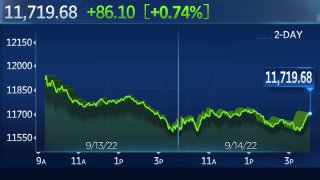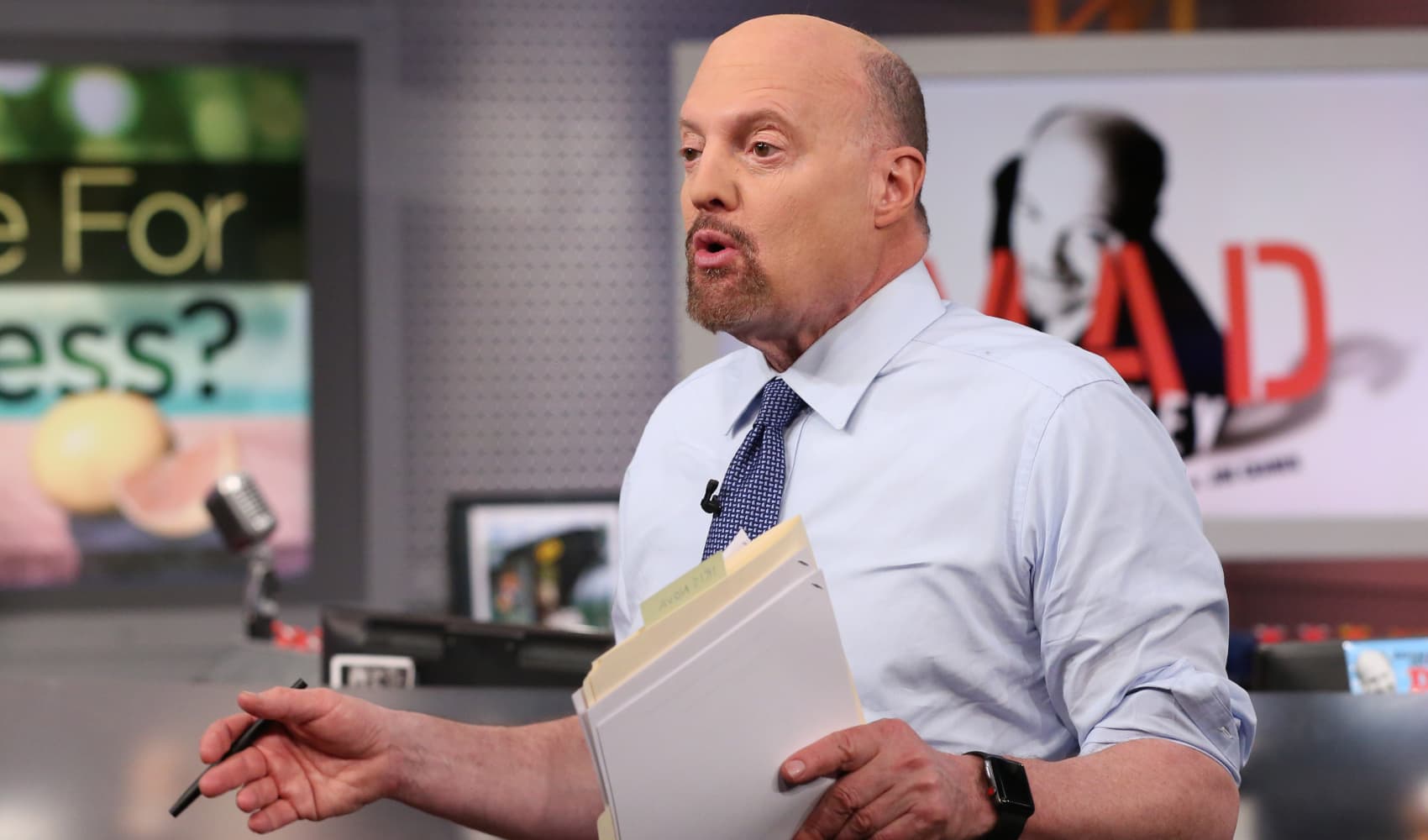
The Nasdaq Composite ground higher in choppy trading on Wednesday as investors tried to find their footing after the biggest one-day drop in more than two years.
The Nasdaq rose 0.74% to 11,719.68. The S&P 500 added 0.34% to close at 3,946.01. The Dow Jones Industrial Average inched up 30.12 points, or 0.10%, to 31,135.09 after being down more than 200 points at session lows.
Moderna was one of the top performers in the Nasdaq, jumping more than 6%. Tesla rose 3.6%, and Apple tacked on 1%.
Get Boston local news, weather forecasts, lifestyle and entertainment stories to your inbox. Sign up for NBC Boston’s newsletters.
The modest gains followed a massive sell-off for stocks on Tuesday. The Dow sank more than 1,200 points, or nearly 4%, while the S&P 500 lost 4.3%. The Nasdaq Composite dropped 5.2%. It was the biggest one-day slide for all three averages since June 2020.
The drop was sparked by August's consumer price index report, which showed headline inflation rising 0.1% on a monthly basis despite a drop in gas prices.
The hot inflation report left questions over whether stocks could go back to their June lows or fall even further. It also spurred some fears that the Federal Reserve could hike interest rates even higher than the 75 basis points markets are pricing in.
Money Report
"Tuesday's selloff is a reminder that a sustained rally is likely to require clear evidence that inflation is on a downward trend. With macroeconomic and policy uncertainty elevated, we expect markets to remain volatile in the months ahead," Mark Haefele, CIO of UBS Global Wealth Management, said in a note to clients.
Market breadth was mixed on Wednesday, with declining stocks slightly outnumbering gainers in the S&P 500. Materials stocks slid, led to the downside by an 11% drop for Nucor.
Lea la cobertura del mercado de hoy en español aquí.
Steel ETF posts worst day in two months as Nucor slumps more than 11%
The VanEck Steel ETF fell 4.2% Wednesday, its worst one-day decline since mid-July, and is now on pace for its worst week since mid-June.
Nucor tumbled more than 11% and U.S. Steel was lower by almost 9% Wednesday.
-- Scott Schnipper and Christopher Hayes
New 52-week lows Wednesday include Intel at weakest in 6.5 years
Wednesday's late day 52-week lows in the S&P 500 included Intel, which fell to the lowest since February 2016.
These were the other 52-week lows made late Wednesday. (An earlier blog post gave the names of stocks hitting 52-week lows shortly after the market's open.)
- Walgreens Boots Alliance lowest since Nov. 2020
- Capital One (Jan. 2021)
- Quest Diagnostics (March 2021)
- Organon (June, 2021)
- Bio-Techne (Jan. 2021)
- A.O. Smith Corp (Oct. 2020)
- NortonLifeLock (May 2021)
- Seagate (Jan. 2021)
- WestRock (Nov. 2020)
Lithium miner Albemarle, spun off from Ethyl Corp. in 1994, reached an all-time high.
—Scott Schnipper and Christopher Hayes
Stocks rally in final minutes, major averages close higher
Stocks bounced in the final minutes of trading on Wednesday, pushing all the three major averages into positive territory. The Nasdaq remained the leader, gaining about 0.7%. The Dow squeaked out a gain of roughly 30 points.
— Jesse Pound
Stocks slip in final hour
The stock market weakened in afternoon trading, with the Dow's losses extending past 200 points. The Nasdaq, which had held above the flatline for most of the day, also turned negative.
— Jesse Pound
Nasdaq clings to gains in afternoon trading
With just over an hour left in the trading session, the Nasdaq Composite is holding on to a gain of 0.2% for the day.
The S&P 500 is down about 0.1%, and has held above the 3,920 level during several dips intraday.
The Dow, which has spent most of the day swinging in a 300-point range, was last down about 100 points.
— Jesse Pound
CFRA's Sam Stovall expects the June low will hold
CFRA's Sam Stovall expects that the June low will hold in spite of a hot inflation report that renewed investor fears of greater interest rate hikes for longer.
Stocks are now digesting the likelihood of a more rapid pace of tightening from the Federal Reserve, which is broadly expected to hike rates by 75 basis points next week, as well as weaker gross domestic product growth in 2022, according to a Wednesday note from CFRA.
Gross domestic product is currently expected to grow by 1.8% in the third quarter, down from 2% previously, read the note. It's expected to jump 1.4% in the fourth quarter, down from expectations of 1.6%.
That's going to add pressure to earnings per share growth in the S&P 500, which has already seen estimates trimmed to 6.9% in 2022, down from 8.9%, read the note.
Still, Sam Stovall said: "Despite the possibility of an additional near-term decline in prices, we still think the June low will hold."
— Sarah Min
Investors Intelligence bullish newsletter editors had edged higher in latest week
Going in to Tuesday's August CPI report, the number of bullish investment newsletter editors surveyed by Investors Intelligence had risen to 32.4% from 29.7% the week before.
The reading two weeks ago was close to the mid-June number of 26.5% that accompanied the bear market low in the S&P 500, and the fewest since early 2016.
Bearish newsletter editors dropped to 28.2% last week from 29.7% the prior week, while the percentage who forecast a correction also retreated, falling to 39.4% from 40.6%.
The so-called "bull-bear spread" widened to +4.2 from 0.0 the week before. Higher bull-bear spreads can sometimes serve as a contrarian signal for more risk, while lower readings are associated with less risk.
— Scott Schnipper
Netflix rises to session highs, advertising plans in focus
Shares of Netflix jumped to session highs following a Wall Street Journal report that the streaming giant projects advertising-supported tier would reach 40 million viewers by the third quarter of 2023.
Netflix announced plans to create an ad-supported subscription plan earlier this year as subscriber growth slowed and even reversed. The company is partnering with Microsoft to build the product, which has not launched yet.
Shares of Netflix were last up 2.9%.
— Jesse Pound
Energy stocks outperform
Energy is the top performing sector in the S&P 500 as oil prices perked up on Wednesday.
Shares of Coterra Energy and APA have jumped more than 7% each. Devon, EOG and ConocoPhillips are also among the top performers in the S&P 500.
Overall, the Energy Select Sector SPDR Fund is up 3.4%, easily outpacing the broader market.
— Jesse Pound
Rails stocks dip as strike fears mount
Rail stocks moved lower on Wednesday after a labor union that represents railroad workers said its members voted against a tentative contract agreement aimed at preventing a potential labor strike.
Workers have threatened to halt work if their demands aren't met for vacation, sick days and several other quality-of-life issues.
The Dow Jones U.S. Railroads Index slumped 3.4%, with shares of CSX Corporation, Union Pacific and Norfolk Southern down 2.3%, 4.4% and 2.5%, respectively.
— Samantha Subin
Major averages hold onto slight gains in aftermath of massive sell-off
Stocks are holding on to modest gains in midday trading. The Nasdaq Composite is in the lead, with a gain of about 0.6%.
Notable movers include Moderna, up 6.6%, and Starbucks, up more than 5%. Tesla has also added a healthy 3.8% on the session.
"Stocks are trying to stabilize, but the whole tape is on edge after the Tues decimation, and few people have much confidence in an immediate rebound," Adam Crisafulli of Vital Knowledge said in a note.
— Jesse Pound
These are the stocks hitting fresh lows
A slew of stocks notched fresh 52-week lows early in Wednesday's trading session.
That included Meta Platforms, which fell about 1.5% and stooped to levels not seen since March 2020. Chipmaker Nvidia also hit a fresh low back dating back to March 2021.
These are some other stocks that made 52-week lows:
- Paramount trading at lows not seen since July 2020
- CarMax trading at lows not seen since May 2020
- Whirlpool trading at lows not seen since July 2020
- Tyson Foods trading at levels not seen since August 2021
- Qorvo trading lows not seen since April 2020
- Western Digital trading at lows not seen since November 2020
- Dow Inc trading at lows not seen since November 2020
- Mohawk Industries trading at lows not seen since October 2020
- Whirlpool trading at lows not seen since July 2020
- Church & Dwight trading at lows not seen since March 2021
- Charter Communications trading at lows not seen since March 2020
- Lumen Technologies trading at lows not seen since November 2020
- Eastman Chemical trading at lows not seen since October 2020
- International Paper Company trading at lows not seen since October 2020
- LyondellBasell trading at lows not seen since November 2020
- Digital Realty Trust trading at lows not seen since March 2020
Meanwhile, shares of Corteva moved slightly higher to trade at an all-time high back to its spin-off from DowDuPont in May 2019.
— Christopher Hayes, Samantha Subin
2-year yield moves higher as market prices in more rate hiking
The 2-year Treasury yield is rising, along with market expectations for what level the Federal Reserve will take its fed funds rate to before it stops raising rates.
The terminal rate is the point where the Fed is expected to end its rate hiking. In the futures market, expectations for where that level will be went from just under 4% ahead of Tuesday's consumer inflation report to 4.38% Wednesday morning.
The 2-year yield topped 3.80% Wednesday, the highest since November, 2007. The yield was at 3.78% in mid-morning trading. The 2-year closely reflects Fed policy moves.
Treasury yields quickly ramped up after Tuesday's report of the August consumer price index, which showed inflation rising instead of falling.
BMO's Ben Jeffery said the 2-year and 3-year yields have been rising with the market's expectations of a higher terminal rate.
"That's definitely why we have the 2-year yields at 3.8%, versus 3.5% a few days ago," said Jeffery.
— Patti Domm
U.S. oil futures move back toward $90 per barrel
Oil prices advanced Wednesday, making back losses from the prior session that saw broad-based selling across assets.
West Texas Intermediate crude futures, the U.S. oil benchmark, advanced 2.18%, or $1.90, to $89.16 per barrel. International benchmark Brent crude added 1.85%, or $1.72, to trade at $94.89 per barrel. U.S. natural gas prices advanced 5.6% to $8.748 per million British thermal units.
The International Energy Agency lowered its forecast for 2022 oil demand growth Wednesday. The firm now expects this year's demand growth to be 2 million barrels per day, down 110,000 barrels per day from prior forecasts.
But the Paris-based agency said the recent decline in fuel prices is also beginning to support demand, according to early indicators.
— Pippa Stevens
Twilio announces layoffs
Twilio is laying off 11% of its workforce as part of a broader restructuring plan, the company announced Wednesday.
The company, which reported 7,867 employees at the end of 2021, has been aiming for profitability in 2023.
Several major tech companies have announced layoffs or slowed hiring over the summer, as recession fears and the drop in the stock market have made companies tighten their belts.
Shares of Twilio were up 1.5% in early trading.
— Jesse Pound, Ashley Capoot
Stocks open slightly higher
Stocks rose modestly at 9:30 a.m., with the Dow gaining less than 100 points. However, the major averages drifted back toward the flatline in the opening minutes of trading.
— Jesse Pound
U.S. 10-year yield trades near key level where it could break higher
Treasury yields continue their inflation-driven move higher, with the benchmark 10-year moving toward a key technical level.
The 10-year yield touched 3.48% earlier Wednesday, just a shade below the 3.5% level that would put it just above this year's high, set in June. The 10-year was at 3.43% in morning trading.
Bank of America strategists say if 3.5% is broken, the next levels could be 3.69%, 3.88% and possibly 3,98% to 4.05%.
Katie Stockton, founder of Fairlead Strategies, said the 10-year broke above another key level this week.
"10-year Treasury yields have extended higher above long-term resistance (~3.25%), leaving a breakout pending this Friday's close. If confirmed, the breakout would support upside follow-through toward secondary resistance near 4.00%, more likely in 2023," she wrote.
— Patti Domm
A 4% one-day decline historically points to better gains, Jeff Hirsch says
A one-day decline of 4% or more may be brutal, but history shows that it can point to better gains in the following session and over the long-term, according to Jeff Hirsch at the Stock Trader's Almanac.
The probability of a rebound on Wednesday after the previous session's sell-off is roughly 66%, according to a Tuesday note from Hirsch.
"Since 1950, S&P 500 has declined 4% or more in a single day 53 times before today [Tuesday]," Hirsch wrote in a Tuesday note. "In those previous 53 occurrences, on the next trading day S&P 500 was higher 35 times and lower 18 with an average gain of 1.08% on all days. Based upon historical performance, the odds of a gain tomorrow [Wednesday] are 66.04%."
History shows that stocks may not meaningfully recover losses in the near-term after a greater than 4% drop, but they can surge by double digits when investors look further out, according to the note.
"[The] line chart of the 30 trading days before and 60 trading days after the last 53 greater than 4% drops does not suggest any significant advance in the near-term as S&P 500 only managed a modest recover, on average over the next 20-25 trading days (a typical month is generally 21 trading days)," wrote Hirsch. "But ... S&P 500 was higher 82.7% of the time one year after a greater than 4% daily decline with an average gain over 25%.
— Sarah Min
Stock futures drift higher again
Stock futures have regained some ground after initially showing little reaction to the release of August PPI numbers.
Dow futures are now up about 71 points, while Nasdaq 100 futures have ticked up 0.4%.
— Jesse Pound
Wholesale prices dip in August
The producer price index for August showed that wholesale price increases were less acute than the pressures facing consumers.
Headline PPI fell 0.1% month over month, matching expectations. When excluding food, energy and trade services, PPI rose 0.2%. Economists surveyed by Dow Jones expected core PPI to climb 0.3%.
In July, headline PPI fell 0.4% and core PPI rose 0.1%.
Some investors and economists could take the low readings for PPI as a sign that consumer inflation will also weaken in the months ahead.
— Jesse Pound
Softbank mulls a third Vision Fund, report says
Masayoshi Son and Softbank are trying to see if the third time is the charm for Vision Funds.
The Wall Street Journal reported on Wednesday that the Tokyo-based investment firm is considering launching another Vision Fund even though its two prior attempts sustained disappointing returns and a few high-profile losses.
The third fund would likely use Softbank's own cash, and the company is also considering adding more money to its second Vision Fund, the Journal reported.
— Jesse Pound
Wholesale price index expected to show decline in August
Markets will get another important inflation reading at 8:30 a.m. ET when the Bureau of Labor Statistics releases producer price index data for August.
Economists surveyed by Dow Jones expect that the PPI, which is a proxy for wholesale prices that goods and services producers receive, fell 0.1%. Excluding food, energy and trade services, the index is expected to gain 0.3%.
The release comes a day after the consumer price index unexpectedly rose 0.1% in August. Core CPI increased 0.6%, double the estimate. On a year-over-year basis, CPI rose 8.3% and 6.3% respectively.
—Jeff Cox
Futures give up gains
Stock futures have lost their modest gains on Wednesday morning, with futures for the Dow, S&P 500 and Nasdaq 100 all hovering slightly above the flatline.
— Jesse Pound
Sharp recession could bring more selling for stocks and bonds, Goldman says
The chances of a Fed-induced recession means that investors can't be too sure that they have seen the worst of the sell-offs for stocks and bonds, according to Goldman Sachs.
"It is particularly hard to be confident in the extent to which lower equity and credit prices or higher bond yields would drive a tightening in financial conditions, given the complex interplay between them," Goldman's Dominic Wilson and Vickie Chang wrote in a note to clients on Tuesday evening.
"But the basic story is clear. If only a severe recession—and a sharper Fed response to deliver it—will tame inflation, then it is likely that the downside to both equities and government bonds could still be substantial, even after the damage that we have already see."
To be sure, Goldman chief economist Jan Hatzius said in the note that he still believes the Fed can bring down inflation without causing a sharp rise in unemployment.
— Jesse Pound
Elon Musk says Fed should 'drop 0.25%'
Cathie Wood's calls for coming deflation got more support on Wednesday morning from Elon Musk, who has a contrarian idea for the Federal Reserve.
Musk said on Twitter that the Fed should "drop 0.25%." The central bank's Federal Open Markets Committee meets next week, and is widely expected to hike its benchmark interest rate by 0.75 percentage points.
Wood's deflation call stems from a sharp decline in commodity prices in recent months. Musk responded to one of Wood's tweets listing falling prices with "exactly, this is neither subtle nor secret."
— Jesse Pound
KeyBanc says buy Walmart, Target
Walmart and Target got buy ratings from KeyBanc, which said both stocks could bolster investor portfolios going forward.
"While investors can find better growth potential in smaller companies, we believe both Walmart and Target are in the best competitive positioning of the past decade, given the pandemic's catalyst of e-commerce becoming significantly more important," wrote KeyBanc Capital Markets analyst Bradley Thomas.
CNBC Pro subscribers can read more here.
— Carmen Reinicke
Traders are now split between a 75 basis point or 100 basis point Fed hike
Some traders are now expecting a full point rate hike from the U.S. Federal Reserve at its September meeting, according to the CME FedWatch tracker of Fed funds futures bets.
The probability of a 100-basis-point rose to 33% from 0%, and the chance for a three-quarter point hike fell to 67% from 91% a day earlier.
Economists at Nomura now also expect to see a full percentage hike.
— Abigail Ng
UK inflation rate unexpectedly dips to 9.9% as fuel prices decline

U.K. inflation slowed in August on the back of a fall in fuel prices, though food prices continued to rise as the country's cost-of-living crisis persists.
The consumer price index rose 9.9% annually, according to estimates published Wednesday by the Office for National Statistics, fractionally below a consensus forecast of 10.2% among economists polled by Reuters. It was also down from July's figure of 10.1%.
"A fall in the price of motor fuels made the largest downward contribution to the change in both the CPIH and CPI annual inflation rates between July and August 2022," the ONS said in its report.
"Rising food prices made the largest, partially offsetting, upward contribution to the change in the rates."
- Elliot Smith
European stocks fall slightly as global markets react to latest U.S. inflation data
European markets were slightly lower on Wednesday as investors reacted to the latest inflation data out of the U.S.
The pan-European Stoxx 600 was down 0.3% in early trade, with travel and leisure stocks slipping 0.9% to lead losses while retail stocks bucked the trend to add 1.9%.
- Elliot Smith
Kevin O'Leary says volatility is back, but could be opportunity
Billionaire investor Kevin O'Leary says there are opportunities in today's volatile market.
"The best thing to do here is — since you can't guess the bottom — is to take opportunities on days like today and buy stocks that you think are attractive," the chairman of O'Shares Investments told CNBC's "Street Signs Asia."
He added that the bulk of the economy is still robust, and the Fed will continue to raise rates until they see "some kind of slowdown."
Read the full story here.
— Lee Ying Shan
CNBC Pro: Morningstar says this is 'one of the best' value-focused funds
For investors, it has been a toss-up between value and growth stocks for much of this year.
As the focus swings back to value, independent mutual fund rating company described one value-focused fund as "one of the best large-value funds available."
CNBC Pro subscribers can read more here.
— Weizhen Tan
Looking for opportunities after Tuesday's steep sell-off
Despite Tuesday's broad sell-off, there are some pockets of opportunity out there for investors looking to play market
Crossmark Global Investments' Victoria Fernandez told CNBC's "Closing Bell: Overtime" on Tuesday that investors may want to focus on healthcare and consumer staples, paying particular attention to quality balance sheets, earnings and management.
Oil prices have come down from their highs despite a big run-up earlier in the year. Investors should remain overweight on energy given that many companies are returning capital to their shareholders and focused on dividends, Virtus Investment Partners' Joe Terranova told "Closing Bell: Overtime."
Many valuations are certainly attractive at these levels but LPL Financial's Quincy Krosby says she's keeping an eye on trading volumes for signs of market strength.
A sell-off on strong volume could indicate more fear in the market, whereas a rally on high volume may signal a healthy one, she points out.
"We didn't see [high volume] as the market moved higher this week," Krosby said. "The volume simply wasn't there to reinforce the notion that the underpinning of the market was stronger."
— Samantha Subin
Why Gundlach says it's time to buy long-term Treasuries
Now is a good time for investors to buy long-term Treasuries, DoubleLine Capital's CEO Jeffrey Gundlach told CNBC's Scott Wapner at the Future Proof Festival on Tuesday.
"In spite of the fact that the narrative today is exactly the opposite, the deflation risk is much higher today than it's been for the past two years," Gundlach said, adding that he expects the assets to outperform next year as deflation becomes a growing threat. "I'm not talking about next month. I'm talking about sometime later next year, certainly in 2023."
CNBC Pro subscribers can read the full story and about the potential risks ahead from deflation here.
— Samantha Subin, Yun Li
Where the major averages stand
This is where all the major averages stand after Tuesday's steep sell-off.
Dow Jones Industrial Average:
- Down 14.4% this year
- 15.8% off its 52-week high
S&P 500:
- Down 17.4% since the start of the year
- Sits 18.4% off its 52-week high
Nasdaq Composite:
- Down 25.6% this year
- 28.2% off its 52-week high
Tuesday's market moves also put all 11 S&P 500 sectors more than 10% off their 52-week highs, with the exception of utilities. The sector sits 2.7% off its high but is up 5.6% this year.
— Samantha Subin
Stock futures open slightly higher
Stock futures opened slightly higher on Tuesday. Futures tied to Dow Industrial Average rose 60 points, or 0.19%. S&P 500 and Nasdaq 100 futures added 0.16% and 0.12%, respectively.
— Samantha Subin






